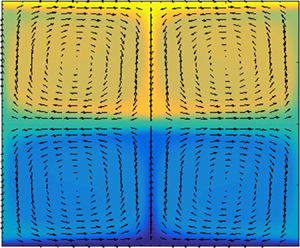Article contents
A self-sustaining process theory for uniform momentum zones and internal shear layers in high Reynolds number shear flows
Published online by Cambridge University Press: 02 September 2020
Abstract

Many exact coherent states (ECS) arising in wall-bounded shear flows have an asymptotic structure at extreme Reynolds number  $Re$ in which the effective Reynolds number governing the streak and roll dynamics is
$Re$ in which the effective Reynolds number governing the streak and roll dynamics is  $\mathit {O}(1)$. Consequently, these viscous ECS are not suitable candidates for quasi-coherent structures away from the wall that necessarily are inviscid in the mean. Specifically, viscous ECS cannot account for the singular nature of the inertial domain, where the flow self-organizes into uniform momentum zones (UMZs) separated by internal shear layers and the instantaneous streamwise velocity develops a staircase-like profile. In this investigation, a large-
$\mathit {O}(1)$. Consequently, these viscous ECS are not suitable candidates for quasi-coherent structures away from the wall that necessarily are inviscid in the mean. Specifically, viscous ECS cannot account for the singular nature of the inertial domain, where the flow self-organizes into uniform momentum zones (UMZs) separated by internal shear layers and the instantaneous streamwise velocity develops a staircase-like profile. In this investigation, a large- $Re$ asymptotic analysis is performed to explore the potential for a three-dimensional, short streamwise- and spanwise-wavelength instability of the embedded shear layers to sustain a spatially distributed array of much larger-scale, effectively inviscid streamwise roll motions. In contrast to other self-sustaining process theories, the rolls are sufficiently strong to differentially homogenize the background shear flow, thereby providing a mechanistic explanation for the formation and maintenance of UMZs and interlaced shear layers that respects the leading-order balance structure of the mean dynamics.
$Re$ asymptotic analysis is performed to explore the potential for a three-dimensional, short streamwise- and spanwise-wavelength instability of the embedded shear layers to sustain a spatially distributed array of much larger-scale, effectively inviscid streamwise roll motions. In contrast to other self-sustaining process theories, the rolls are sufficiently strong to differentially homogenize the background shear flow, thereby providing a mechanistic explanation for the formation and maintenance of UMZs and interlaced shear layers that respects the leading-order balance structure of the mean dynamics.
JFM classification
- Type
- JFM Papers
- Information
- Copyright
- © The Author(s), 2020. Published by Cambridge University Press
References
REFERENCES
- 13
- Cited by



